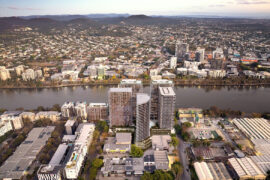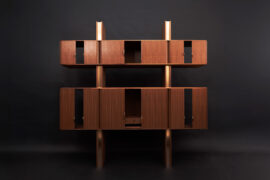Fai Au, founder of O Studio Architects, talks about a project modelled after a seed and the firm’s approach to design.
February 28th, 2012
The Church of Seed, which sits perched atop China’s sacred mountain, Mount Luofu, takes its inspiration from a seed – an oft-mentioned metaphorical element in the Gospel stories.

Church of Seed is the first western religious building on Mount Luofu, one of 7 famous sacred Taoist mountains in China.
Its main structure is made from in-situ concrete with bamboo formwork and is defined by 3 curved walls that together form the shape of a seed. A stepping roof terrace allows diffused northern daylight to penetrate the interior while providing a dramatic ceiling height increment of 3 to 12 metres from the main entrance to the place of worship. Above, visitors can make their way up the stepping roof to an observation deck that affords wide-ranging views of the mountain landscape.

The curved walls split to form 3 openings in the structure.

An observation deck on the roof from which to take in the view.
The abstract form and space of the church is conveyed through the play of light, shadow, material and texture. And as is likely the intention, the severe, bare-boned simplicity evokes a quiet sense of awe – paradoxically also keeping it close to the surrounding village life.
There has been some debate over its similarities to Le Corbusier’s Notre Dame du Haut in Ronchamp. But before you decide, read on for our interview with the studio’s founder and principal, Fai Au.
How did the idea of using the concept of a seed as the project’s starting point come about?
The idea of ‘seed’ came along in the series of discussions between the client and us. Seed is a metaphorical element [that] frequently appears in the Gospel stories. Eventually it became our design inspiration.

The concrete walls are made less stark with bamboo formwork.
What were come of the most important considerations for you with this project?
One of the most important considerations was to use bamboo formworks for the concrete structure. This is an economically sound construction method. The bamboo texture left on the concrete wall surfaces gives great visual excitement.

The chairs are made from bamboo by local farmers.
What sort of experience is this building designed to give the visitor?
This building provides not only [a] worship and meditation space for Christians, but also [a] gathering place for the local village people. The design demonstrates a great play of light and shadow, which makes the place sacred yet exciting.

The cross-shaped opening on the southeast facing wall introduces morning sun into the interior.
It appears that sensitivity to culture and place informs your work, both in Church of Seed as well as other projects.
Sensitivity to culture and place is essential for every project we have done. We do not favour a signature style or fixed architectural language for projects. Through our design, we intend to respond to the local culture and site characteristics of various projects.
Your website states that the studio intends to pursue “form-making and sustainable design” in a “primitive and fundamental” way. Can you give an example from your work?
Fanling Class Car Museum is a great example. In this project, we use [a] series of circular zones to preserve all of the existing trees on site. This is a straightforward approach that does not only respects the natural environment, but also transforms the existing environment into an exciting background for the car exhibition.
What are you working on at the moment?
We are currently working on several hotels, mixed-use master planning projects and luxurious houses in Hong Kong and Mainland China.
O Studio Architects
ostudioarchitects.com
INDESIGN is on instagram
Follow @indesignlive
A searchable and comprehensive guide for specifying leading products and their suppliers
Keep up to date with the latest and greatest from our industry BFF's!
The new range features slabs with warm, earthy palettes that lend a sense of organic luxury to every space.

A longstanding partnership turns a historic city into a hub for emerging talent

Welcomed to the Australian design scene in 2024, Kokuyo is set to redefine collaboration, bringing its unique blend of colour and function to individuals and corporations, designed to be used Any Way!

For Aidan Mawhinney, the secret ingredient to Living Edge’s success “comes down to people, product and place.” As the brand celebrates a significant 25-year milestone, it’s that commitment to authentic, sustainable design – and the people behind it all – that continues to anchor its legacy.

Events continue apace at Tadao Ando’s MPavilion in Melbourne’s Queen Victoria Gardens, as Season 11 progresses into 2025.

A look at the 2018 NAWIC Awards for Excellence proves that there is plenty of innovation and inspirational leadership being done by women in construction.
The internet never sleeps! Here's the stuff you might have missed

Plus Studio and ICD Property have submitted a proposal for a development on Brisbane’s Donkin Street, using a 1.68-hectare former industrial site as a new riverside residential and community destination.

Carr’s largest residential project to date integrates concrete, steel mesh and landscape across 122 apartments in Melbourne’s Brunswick.

Adam Markowitz Design, in collaboration with Simeon Dux, has been awarded The Object at the INDE.Awards 2025. Their winning project, A Cabinet of Curiosities, is a masterwork of craftsmanship and adaptability; a poetic response to shifting domestic and professional life in the post-COVID era.